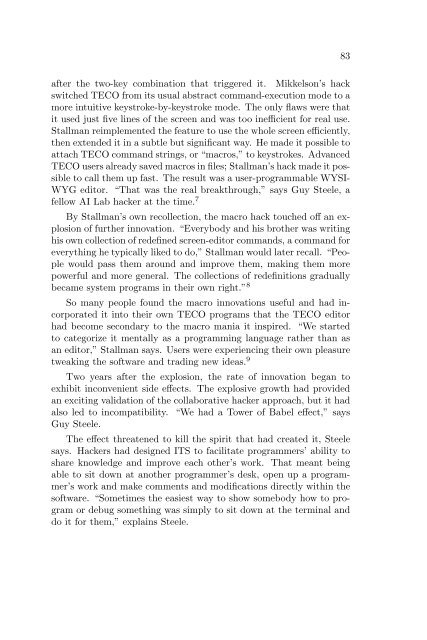You also want an ePaper? Increase the reach of your titles
YUMPU automatically turns print PDFs into web optimized ePapers that Google loves.
after the two-key combination that triggered it. Mikkelson’s hack<br />
switched TECO from its usual abstract command-execution mode to a<br />
more intuitive keystroke-by-keystroke mode. The only flaws were that<br />
it used just five lines of the screen and was too inefficient for real use.<br />
Stallman reimplemented the feature to use the whole screen efficiently,<br />
then extended it in a subtle but significant way. He made it possible to<br />
attach TECO command strings, or “macros,” to keystrokes. Advanced<br />
TECO users already saved macros in files; Stallman’s hack made it possible<br />
to call them up fast. The result was a user-programmable WYSI-<br />
WYG editor. “That was the real breakthrough,” says Guy Steele, a<br />
fellow AI Lab hacker at the time. 7<br />
By Stallman’s own recollection, the macro hack touched off an explosion<br />
of further innovation. “Everybody and his brother was writing<br />
his own collection of redefined screen-editor commands, a command for<br />
everything he typically liked to do,” Stallman would later recall. “People<br />
would pass them around and improve them, making them more<br />
powerful and more general. The collections of redefinitions gradually<br />
became system programs in their own right.” 8<br />
So many people found the macro innovations useful and had incorporated<br />
it into their own TECO programs that the TECO editor<br />
had become secondary to the macro mania it inspired. “We started<br />
to categorize it mentally as a programming language rather than as<br />
an editor,” Stallman says. Users were experiencing their own pleasure<br />
tweaking the software and trading new ideas. 9<br />
Two years after the explosion, the rate of innovation began to<br />
exhibit inconvenient side effects. The explosive growth had provided<br />
an exciting validation of the collaborative hacker approach, but it had<br />
also led to incompatibility. “We had a Tower of Babel effect,” says<br />
Guy Steele.<br />
The effect threatened to kill the spirit that had created it, Steele<br />
says. Hackers had designed ITS to facilitate programmers’ ability to<br />
share knowledge and improve each other’s work. That meant being<br />
able to sit down at another programmer’s desk, open up a programmer’s<br />
work and make comments and modifications directly within the<br />
software. “Sometimes the easiest way to show somebody how to program<br />
or debug something was simply to sit down at the terminal and<br />
do it for them,” explains Steele.<br />
83


